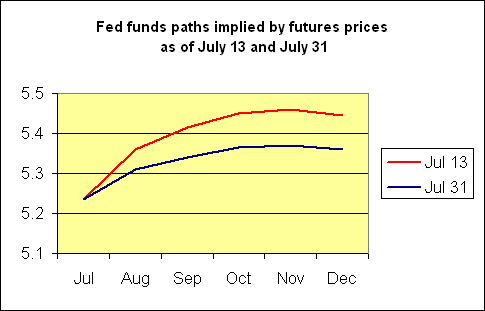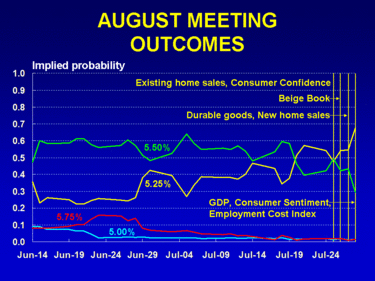A few weeks ago I noted that the fed funds futures contracts seemed to reflect an expectation that we’d see one more rate hike this fall, and that would be it. But a lot can change in two weeks. Now the message looks more like, “that’s it!”
 |
As of July 13, a contract whose payoff depended on the average fed funds rate during November was trading at an implied rate of 5.46%, suggesting one more bump from the current 5.25% target at one of the next three FOMC meetings. That November contract has since drifted down to 5.37%, meaning it’s even money whether there will be even a single hike at any of the next three meetings, and relatively unlikely that, if another hike is selected, it would come as quickly as the August 8 meeting.
 |
Macroblog notes a similar conclusion from options prices, which suggest that traders now see only a 30% chance of a hike at either the August or September meeting. And Bloomberg today notes statements by FOMC Member Janet Yellen and FOMC Alternate Member William Poole suggesting they might be comfortable leaving the funds rate where it is for now.
 |
| Measure | Past 6 months | Past year |
|---|---|---|
| CPI | 4.7% | 4.3% |
| CPI less food-energy | 3.2% | 2.7% |
| median CPI | 3.9% | 3.2% |
| trimmed-mean CPI | 3.0% | 2.9% |
| GDP deflator | 3.3% | 3.3% |
| PCE deflator | 3.1% | 3.3% |
So what’s changed? Not good news about inflation, surely. Recall Fed Chair Bernanke’s remarks from less than two months ago:
While monthly inflation data are volatile, core inflation measured over the past three to six months has reached a level that, if sustained, would be at or above the upper end of the range that many economists, including myself, would consider consistent with price stability and the promotion of maximum long-run growth. For example, at annual rates, core inflation as measured by the consumer price index excluding food and energy prices was 3.2 percent over the past three months and 2.8 percent over the past six months. For core inflation based on the price index for personal consumption expenditures, the corresponding three-month and six-month figures are 3.0 percent and 2.3 percent. These are unwelcome developments.
There is basically no way to slice the inflation data since then to come up with numbers that are any lower than these “unwelcome” numerical guidelines that Bernanke identified.
The data arguing for a pause come instead from the real side. In particular, the new home sales figures released Thursday paint a pretty clear picture that the housing slowdown we’d all worried about is now well underway. Falling residential construction made a negative contribution to second quarter GDP and has considerably more downside potential. Some of my ongoing research suggests that what the Fed has already done won’t have its biggest negative effect on new home sales until December. Regardless of what the Fed does now, the housing slowdown is likely to become more dramatic this fall, a theme echoed by Nouriel Roubini and Mark Thoma.
The risks for real output of another immediate rate hike are all too obvious. What about the risks to inflationary expectations if there is a pause? The response in markets such as gold and the dollar was pretty dramatic the last time the pause balloon was floated. However, I continue to believe that a decline in the level of real economic activity is fundamentally a very bearish development for commodity markets, and that longer term, Bernanke means what he says about not allowing 3% inflation to persist. If speculators bet against either of those propositions, they could end up losing big.
But then again, we won’t know for sure until after it’s all played out, will we?
Technorati Tags: macroeconomics,
Federal Reserve,
interest rates
My take is that with oil supply seemingly constrained, the level of achievable real economic growth is now lower than it was a few years ago. Therefore, monetary policy will have to target a lower level of real growth or risk causing inflation. This is not to say that cyclical factors could not temporarily overwhelm that consideration, and indeed a pretty significant housing led slowdown seems very likely in late 2006 and 2007. Other things being equal, that might argue for a pause.
Other things are not altogether equal, however: obviously events in the Middle East this month have greatly heightened the risk of some kind of oil shock, particularly if the US and Iran continue on a collision course as seems likely at present. It does not seem to me that Israel has the means/will to do what it takes to remove Hezbollah from Southern Lebanon, and so that conflict could go on for a long period of time. With that as background a US attack on Iran is now going to be interpreted as a US/Israeli attack on Iran and Lebanon together, and infuriate Muslims everywhere. The oil weapon is the main leverage Middle Eastern countries have, and if the pro-Western regimes won’t use it, their stability will be threatened. Obviously, anything could happen, but it’s hard to have solid confidence that the flow of oil will continue uninterrupted over the next 12 months.
In the event of a significant oil shock, interest rates will have to go higher to contain the resulting inflation.
fed has to raise to fund trade+fiscal deficit..if fed pauses, dollar will tank. It will not be pretty.
Maybe they should surprise everyone and lower rates. They’re going to do so sooner rather than later anyway, is my guess. Might as well get a jump on things.
You can balance a broom on your forehead with slow, measured movements as long as everything is under control. When things start to get out of hand you need to start jerking around or everything will fall apart. All this quarter-point per meeting stuff has to go out the window. They should yank it up or down a half point or more each time. You don’t drive a car on a bumpy road without twisting the steering wheel pretty violently. Hope that’s enough metaphors for you.
Looks like Bernanke is stuck in an uncomfortable place between a rock and a hard spot, otherwise known as stagflation.
Yeah,
I love how a low GDP number and high PCE deflator could entice investors back into the markets. It’s like they have money to burn. And that seems to be the underlying problem. Too much global liquidity that I believe that U.S. will have to take the lead in mopping up.
Hal, I hardly see how you can call GDP growth of 2.5% and core inflation of around 3.5% stagflation. Take a look back at conditions in the 70s, that was stagflation, this is not.
GWG,
Yep, we have case of linguistic grade inflation underway. If this is stagflation, what word are we going to dream up for any future bout of 10% inflation and trend real growth around 1.8%? In fact, the word never meant anything useful. If “stagflation” is all we know about a situation, we only know enough to complain, not enough to act.
kharris, that’s a exceptionally insightful comment, imho.
It’s certainly true this is very mild stagflation, but then the oil supply constraint has been very mild compared to what happened in the 1970s (so far, anyway).
Sometimes we see what we want to see.. actually the funds market place is forecasting or at least pricing the probability of..
Given a pause in August the probaiblity close to 40% conditionally that the FED will resume its tightening path again in either September or October..
Nice smooth done for all time paths have been a thing of the past for months..
If they are uncertain as to what will happen day’s before an FOMC who is to say they won’t be “uncertain” again at the next and the next..and……
This doesn’t have to be a binary solution. Why not raise rates by 7 bps, or 16 bps? That would be more precise, right?
I blogged on this today and — despite needing a sanity check on the concept — I think it would be the right solution.
A while ago I kept hearing about the other two inflation shoes that haven’t dropped: food and wage inflation.
Would a minimum wage increase or an extended heat-wave in the crop regions have any signifcant effect on inflation? Or maybe even a constraint on immigrant labor?
I don’t think my post was entirely clear.
Would a reduction in the flow of illegal immigration result in inflation pressures?